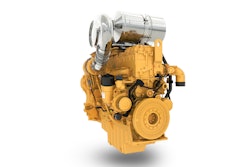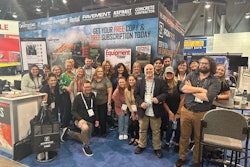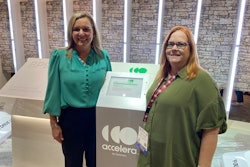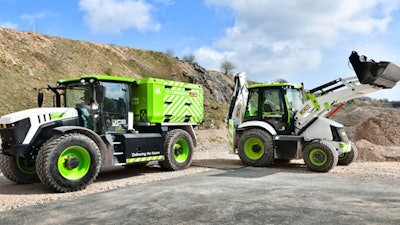
During CONEXPO’S huge five-day run in Las Vegas this year, one of the most interesting trends was the number of hydrogen-powered units on display. Perhaps one of the most advanced new production introductions was that managed by JCB when it displayed its hydrogen internal combustion engine (HICE).
Initially, JCB had designed an excavator that used a hydrogen fuel cell. But after extensive testing, JCB decided fuel cell technology was not the best option for their customers at this time, and they decided to move toward a hydrogen-combustion solution.
Now, JCB is investing $1.2 million (£100 million) to produce super-efficient hydrogen engines. The company has showcased working prototypes of a backhoe loader and telescopic handler powered by hydrogen.
The company also have announced another industry first—a mobile hydrogen refueller, providing a quick and easy way for customers to refuel machines onsite. About 97% of construction machines have fuel delivered to them onsite, and customers are used to using transportable fuel, which allows refueling onsite in minutes.
JCB also has a range of electric-powered vehicles, but these are not always a realistic solution for all customers. Instead, JCB has developed a diversified approach, one that encompasses multiple forms of alternative fuel and helps achieve carbon-neutral goals. Currently, the most important and most mature alternative is hydrogen.
Hydrogen is the most abundant element in the universe, and there is tremendous potential for a hydrogen ecosystem using both hydrogen fuel cell system technology (FCEV) and the relatively new HICE.
Fuel cell systems generate electricity using hydrogen, and their only emission is water vapor. HICE burns hydrogen as a fuel source for an internal combustion engine (ICE) and emits gasses into the atmosphere.
The Differences between HICE and FCEV
Since both technologies are similar, the choice for customers generally comes down to their unique operating environments. HICE units are more efficient under heavy loads and can be refilled quickly. However, they sometimes are difficult to start in cold weather, and there can be packaging problems for the storage tanks. FCEVs are more attractive with light loads, such as passenger cars, and they provide regenerative braking.
HICEs
Hydrogen engines burn hydrogen in an ICE in the same way gasoline or diesel is burned in an engine. In fact, HICEs are nearly identical to traditional spark-ignition engines. Hydrogen engines release near zero, trace amounts of carbon dioxide (CO2) from ambient air and lubrication oil but can produce nitrogen oxides (NOx). As a result, they are not ideal for indoor use and require exhaust aftertreatments to reduce NOx emissions. The way hydrogen is made can also have an impact: green hydrogen (hydrogen made with renewable energy) is desirable, but currently most produced hydrogen is gray hydrogen (see Table 1). As a result, purists consider HICE vehicles not to be true zero emissions vehicles.
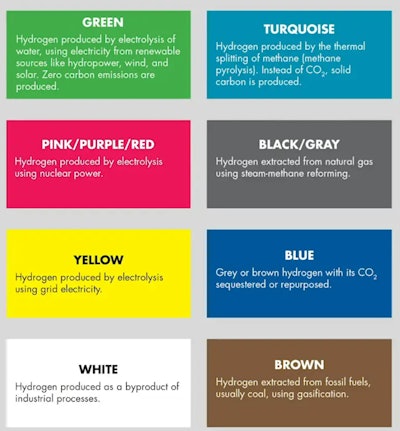 Table 1. The hydrogen spectrumNorth American Council for Freight Efficiency
Table 1. The hydrogen spectrumNorth American Council for Freight Efficiency
Hydrogen engines can operate with lower grade hydrogen. This is handy for specific use cases, for example, site-produced hydrogen. HICE can use this without the need for purification. The engine’s resistance to impurities is also convenient for a transportation industry where the transition to high-quality green hydrogen will take time.
HICE are generally considered to have a high level of maturity as ICEs have been universally used for decades and are supported by extensive service networks. For manufacturers and fleet operators, the switch to hydrogen engine drivetrains involves familiar parts and technology. Risk-averse end-users find comfort in the tried-and-tested, reliable nature of ICEs. Servicing and repairs are also easier for HICE because the technology is familiar to most users.
FCEVs
FCEVs generate electricity in a device known as a fuel cell that uses hydrogen to generate electricity. That electricity is used by an electric motor like it’s used in an electric passenger vehicle. They also use a battery pack, although it is much smaller than that of an electric vehicle. Water vapor is the only emission they produce. This is a very attractive feature for vehicles operating in spaces with limited ventilation.
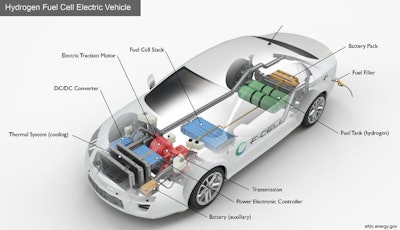 A FCEV schematic showing the fuel cell, hydrogen tank and battery packU.S. Department of Energy
A FCEV schematic showing the fuel cell, hydrogen tank and battery packU.S. Department of Energy
FCEVs are designed to enhance and build upon battery and electric drive platforms. While each system has advantages, combining the developing technologies of batteries and fuel cells helps reduce overall carbon and increases adoption of sustainable power without affecting performance. This allows users to address distance and refueling issues that have hindered the adoption of battery electric vehicles for some applications. So, in FCEVs batteries will not be replaced by fuel cells, but they will be enhanced by them.
HICEs or FCEVs?
Picking between these two hydrogen power sources often comes down to one’s operating environment, as we’ll see. A shortage of hydrogen fueling structure poses problems for both, as well, but both are fueled more quickly than battery EVs can be charged.
Power Type | Pros | Cons |
HICE |
|
|
FCEV |
|
|
While engine efficiencies suggest that battery electric vehicles are the way forward, other factors such as range, refueling time, battery weight, end-of-use recycling, infrastructure, environmental impact, carbon costs and fuel cost must also be considered. An FCEV is an electric car with its own on-board power station and fuel storage instead of a battery, so they have most of the advantages of electric vehicles.
Efficiency Problems
Efficiency is a problem for both HICE and FCEV vehicles. There are many ways to measure the efficiency of a vehicle. In the chart below, we look at engine efficiency combined with the efficiency of fuel production and distribution.
There are often extreme outliers to bear in mind, such as the efficiency of a Formula 1 car can be several times that of a gasoline ICE when measuring only engine thermal efficiency.
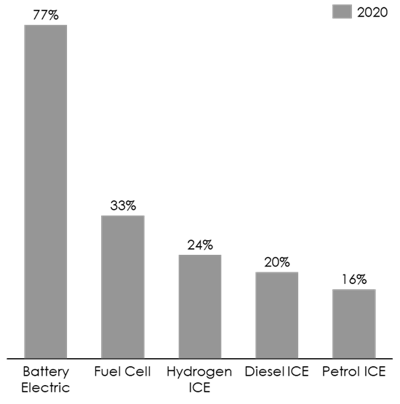 Figure 1. Engine efficienciesPower Systems Research
Figure 1. Engine efficienciesPower Systems Research
The engine efficiencies suggest that battery electric is clearly the way forward. However, the choice of energy source is not just about engine efficiency because many other factors come into consideration, including:
- Range
- Refueling time
- Battery weight
- End-of-use recycling
- Infrastructure
- Environmental impact and carbon costs
- Fuel cost
Summary
FCEVs and HICEs do not compete with one another. The development of one supports the other, since both drive the growth hydrogen production, transportation and distribution infrastructure. Both also involve the same vehicle storage tanks and are complementary technologies that are part of reducing vehicle and transportation emissions towards zero carbon. Ultimately, it’s not a matter of which technology is better, but rather which is more suitable to an end user’s conditions, applications and needs.




